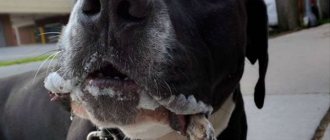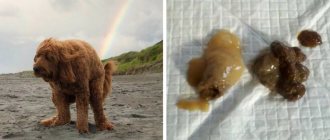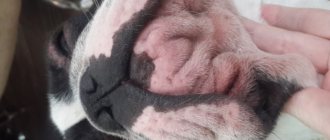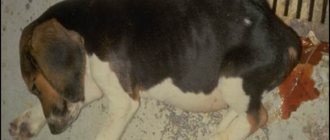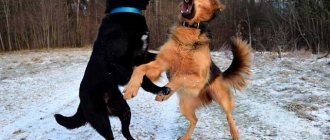Features of the structure of the nose in dogs
It has long been noted that a dog’s nose should be moist and cool. The moisture in the nose is ensured by the constant secretion of special mucus, which is evenly distributed throughout the animal's nasal mucosa. The main purpose of this lubricant is to form a special filter, invented by nature, with the help of which the dog distinguishes odors much better.
If the nose dries out, the ability to better distinguish odors is lost. In wild living conditions, this can have dire consequences: it did not recognize the prey, did not eat on time, fell ill, or died. Fortunately, most dogs on planet Earth do not face such a fate, since people themselves find food for their younger brothers, completely ensuring their survival.
Science claims that a dog's wet nose increases the ability to distinguish odors several times, to accurately recognize where they came from, and to separate the overall smell into its constituent components. The nose, like the tongue, is a thermostat, one of the organs for maintaining constant balance in the animal’s body.
What diseases cause the nose to be dry and warm?
Remember!
Humans also suffer from rabies. A sick animal poses a mortal threat to the people and animals around it.
Pets are unable to communicate when they feel unwell. But a caring owner can always notice this himself based on various signs. One of the main indicators of a dog’s well-being is the condition of the nasal mucosa.
The mucous membrane can be dry or moist, hot, warm or cool, clean, with ulcers or wounds. All violations indicate that the functions of this organ are not fully performed, and the reason may lie in both pathology and external conditions.
In dogs, unlike humans, the mucous membrane is located not only inside the nostrils, but also on the surface of the olfactory organ. It contains a large number of small glands that constantly secrete a mucous secretion. This lubricant performs an important function: it contributes to the perception and enhancement of all odors that surround the animal. As you know, for a dog, smell plays the role of the most important sense with which the pet navigates the surrounding world, so the loss of this ability is reflected in general behavior.
In order for the humidity to be maintained at the desired level, the nose should be moderately cool. When its temperature rises, the mucous membrane dries out faster than a new secretion can be produced.
Causes of a warm nose in a dog
It’s worth noting right away that a dog’s dry nose does not necessarily indicate the presence of health problems. Experienced dog breeders say that if a dog has a dry and warm nose, this may indicate:
Temporary dehydration of the body. This problem is easily solved. The owner should place a bowl of clean water within reach. Considering that dogs often eat bones, water is vital for them, as it is actively used to create digestive juices for digesting heavy food.
Temperature extremes (high, low). The animal does not have time to adapt to weather conditions, which leads to temporary drying of the mucous surface of the dog’s nose. As soon as the weather returns to normal, the natural state of the dog’s nose will also return to normal;
Natural state of a dog. If from a very young age the dog had a tendency to have a dry, warm nose, this does not mean that it was sick. This is especially true for small individuals;
The beautiful creature has just woken up. Veterinarians say that during sleep, the dog’s body heats up intensely, which leads to drying of the nasal mucosa not only on visible surfaces, but also inside. After the pet gets up, runs a little, drinks some water, scratches itself, the nose will quickly return to normal. To summarize, we can say that if you notice that your pet’s nose has dried up, but his behavior is still characterized by the same cheerfulness and ease, then there is no reason to worry.
In what cases does a hot nose indicate an animal’s illness?
- Allergic reactions are the most common problem. Associated signs: the pet constantly scratches its skin, covers its muzzle with its paws and becomes very nervous. Constant body twitching, dandruff and flaking of the skin appear. It is very difficult to independently determine the allergen and it is hardly possible to do without the help of a specialist. Of course, you can try replacing all the animal’s dishes with stainless or ceramic ones, and removing all synthetic items and carpets. The diet will also have to be radically changed: only porridge and broth will be left. Carry out wet cleaning of premises more often, refusing to use household chemicals. You should note in a notebook every item that is removed from your dog's use. Walk your animal away from flowers that can cause allergic reactions. As soon as you notice an improvement in your animal, immediately go to the doctor for further therapy. Sometimes tests can identify the type of allergen, but if this doesn’t work the first time, continue to keep a diary and write down all the items that you remove from your pet’s household. Only with such small steps can one cope with this disease and detect the allergen.
- Pemphigus is a completely immune disease. The main symptoms of the disease are the appearance of blisters on the nose or body of the animal. The bubbles burst, leaving a crust in its place. It can only be detected with the help of tests that confirm one or another type of pathogen.
- Cold. It can occur in the form of a common runny nose, or it can develop into a more severe form - pneumonia. It is worth remembering that this complication is much more severe in dogs than in people and ends in death much more easily. Therefore, it is very important to show your pet to a veterinarian in a timely manner. The specialist will examine the dog's chest, listen to it and decide what to do next.
- Plague. A very acute disease that quickly becomes severe. Signs: apathy, formation of pus on mucous surfaces. Diarrhea and vomiting mixed with blood, convulsions.
- Rabies. This disease poses a serious threat to both animals and people. In animals, unfortunately, it is incurable. Signs: photophobia, aggressiveness, lack of appetite, but the dog is very thirsty. If a dog gets rabies, it is euthanized.
If you notice certain symptoms in an animal, you should not worry about guessing, but immediately visit a veterinarian, because sometimes an extra minute will help save your pet’s life.
When should you worry about your dog's nose?
So, we have already looked at some of the reasons why a dog has a warm and dry nose. If the desiccation of an organ is accompanied by lethargy, apathy, and loss of appetite, you should start to worry, since this may indicate an imbalance in the animal’s body. It can be:
- a variety of allergic reactions;
- injuries received;
- problems with the digestive system, including parasitosis;
- the onset of a cold;
- development of pemphigus.
Allergy
Just like in humans, allergies in dogs are quite common. The dog reacts very sharply to incorrectly selected food, a sudden change in the usual diet, the use of cheap plastic plates that contaminate food with toxins, poor-quality bedding, the presence of strong aromatic substances in the air, and plant pollen.
Often an allergy indicates the presence of worms that need to be gotten rid of; fortunately, the arsenal of modern medicine for treating this scourge is extremely wide. The absence of parasites is not only a guarantee of good health for a furry domestic animal, but also confidence that its worms will not move into the owner, which can be very dangerous, especially if you catch echinococcus, which can cause the death of the dog owner.
For obvious reasons, you should not immediately put your pet on antihistamines, which will bring little benefit. It is better to systematically and purposefully look for the cause of acute reactions that indicate trouble. Dog handlers advise not to use plastic bowls, especially for water, to construct bedding from natural fabrics with minimal use of dyes, and to observe how the dog reacts to this or that food.
Injuries
The inflammatory process due to injury can also dry out the dog's nose. In this case, there will be a reluctance to move, a tendency to rest frequently, drowsiness, lameness and other symptoms. In this case, you need to provide your pet with quality rest for a while, allowing him to regain his strength.
Infections
If your dog has a warm, moist nose, this may indicate the presence of an infectious disease. Measuring your temperature can confirm your guess, especially if it is above 39 degrees. If it is clear that the dog has contracted an unpleasant disease, you need to look for the cause that caused it, go to the veterinarian, who can choose the right treatment, improve the diet, making it natural and as varied as possible. When poor health is accompanied by signs of diarrhea and vomiting, the nose will become not only dry, but also very hot due to lack of fluid in the body.
Cold
Some people don’t even realize that dogs can catch a cold, especially if they have to sleep in a room where there are constant drafts and no basic heating. In this case, the nose will be dry and cold. In this case, phenomena such as periodic sneezing, coughing, wheezing during breathing, snoring during sleep (due to nasal congestion), muscle tremors (increased body temperature) will be observed. In such cases, it is worth reducing the calorie intake, ensuring easy access to water, keeping the pet in a warm, dry room, and temporarily limiting walks in cold air.
Pemphigus
Sometimes your pet's nose becomes dry and covered with crusts that fall off. Small blisters constantly form, which open on their own, and new ones appear in their place. This unpleasant symptom indicates that the dog is developing a disease associated with disruption of the proper functioning of the immune system - pemphigus. It is unlikely that you will be able to cope with it on your own without professional help; you should go to the veterinarian.
Other serious diseases
A warm nose may also indicate the development of distemper and even rabies. But you shouldn’t make such diagnoses right away. These diseases have very clear symptoms, when the dog refuses food, staggers, falls on its side from weakness, and pus is discharged from the nose and eyes. And with rabies, the pet will look for a secluded place for complete privacy, and will react sharply to light and the presence of people.
Cold nose
A too cold surface of the lobe may be a sign of a significant decrease in the animal’s body temperature. The rest of the body is covered with fur, so it is the nose that gives an idea of the coolness of the skin.
There are several reasons for this phenomenon:
- hypothermia;
- colds or viruses;
- serious malfunctions in the functioning of internal organs.
In this case, the main signals indicating that the dog urgently needs to be shown to a specialist are:
- dull or watery eyes;
- bloodless gums;
- cold surface of the ears;
- wheezing.
General recommendations
So, every dog owner should understand that if the dog’s nose is dry and hot, you should not immediately run to the veterinarian. You just need to carefully observe the behavior of your ward. If the behavior does not change, the animal is active and mobile, eats with appetite, then there is nothing to worry about. If deviations in the condition of the nose are accompanied by a pronounced change in the physiological balance of the animal, then it is worth looking for the reason that caused it, calling on the professional experience of a veterinarian to help. He will help make the correct diagnosis and prescribe the correct treatment.
In order for your pet to always be in excellent condition, you need to regularly perform the same actions: avoid dehydration, diversify the menu, regularly walk it, clean it from parasites every quarter. It is important not to use hygiene products that can cause an allergic reaction, to maintain optimal temperature conditions for living (so that it is neither too cold nor too hot), and if the inflammatory process begins, immediately seek medical help.
Currently reading:
- 6 Factors for a Cold or Wet Dog's Nose
- Seven Signs and Remedies for Getting Rid of Fleas in Dogs
- How and with what to treat a runny nose or rhinitis in dogs
- Tips for proper dog burial
Hot and dry
Too high a temperature in the nasal mucosa is almost always combined with dryness. This symptom always indicates a disease that causes fever. The reasons for this include infectious pathology or significant trauma, as well as an inflammatory process. First of all, it is important to make sure that the dog is not experiencing heatstroke.
Immediate contact with a veterinarian is necessary in cases where a hot and dry nose is combined with the following symptoms:
- weakness, lethargy and sleeping longer than usual;
- constant desire to drink;
- loss of appetite;
- increased irritability and aggression;
- the dog tries to hide in a secluded place where no one will disturb him;
- obvious intestinal disorders (diarrhea, vomiting);
- swelling of the nose;
- blisters and peeling on the mucous membrane;
- frequent sneezing and paroxysmal cough, runny nose;
- hoarse voice.
It's good if the dog can measure the temperature. The values for this parameter differ for dogs of different ages and sizes, and also change in pregnant or lactating bitches.
